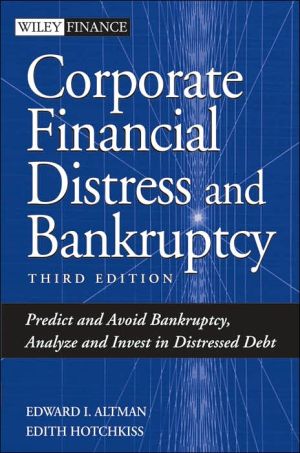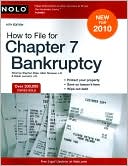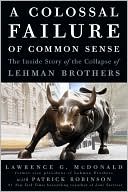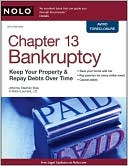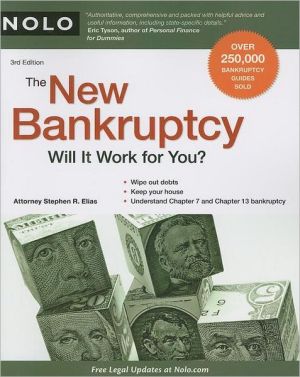Corporate Financial Distress and Bankruptcy: Predict and Avoid Bankruptcy, Analyze and Invest in Distressed Debt
In this newly revised Third Edition of Corporate Financial Distress and Bankruptcy, credit and corporate bankruptcy experts Ed Altman and Edith Hotchkiss update and expand the discussion of corporate distress and bankruptcy, as well as the related markets dealing with high-yield and distressed debt. In addition to expanded empirical and descriptive aspects of bankruptcy and credit analysis, this Third Edition offers state-of-the-art analysis and research on the costs of bankruptcy, credit...
Search in google:
Since the publication of the last edition of Corporate Financial Distress and Bankruptcy in 1993—considered by many to be the most authoritative finance book on this topic—the fields of corporate distress and bankruptcy, as well as related markets dealing with high-yield and distressed debt, have undergone enormous growth and change. Today, there's no doubt that bankruptcy is a big business, and over the last decade both professionals and academics have become increasingly interested in the activities surrounding this phenomenon. In this newly revised Third Edition of Corporate Financial Distress and Bankruptcy, credit and corporate bankruptcy experts Ed Altman and Edith Hotchkiss update and expand the discussion of corporate distress and bankruptcy, as well as the related markets dealing with high-yield and distressed debt. In addition to expanded empirical and descriptive aspects of bankruptcy and credit analysis, this Third Edition offers state-of-the-art analysis and research on the costs of bankruptcy, credit default prediction, bankruptcy and distressed restructuring, and the post-emergence period performance of bankrupt firms.Divided into two comprehensive sections, Corporate Financial Distress and Bankruptcy, Third Edition addresses a number of key issues central to your understanding of the restructuring process in Section One and deals with the development and implications of models built to classify and predict corporate distress in Section Two. Specific topics covered in the opening section include:An introduction to, and statistical background of, corporate distress and bankruptcyEvolution of the U.S. Bankruptcy Code, including the Bankruptcy Reform Act of 2005, and international comparisonsPost–Chapter 11 performanceDistressed firm valuationHighly leveraged restructuringsInvesting in distressed securitiesThe high-yield bond market: risks and returns for investors and analystsCorporate governance in distressed firmsIn Section Two, models for estimating default probabilities are discussed, followed by explanations of their applications to many different scenarios, including distressed debt investing, turnaround management and other advisory capacities, and legal issues. With respect to the discipline of turnaround management, you'll become familiar with the possibility of using distressed firm predictive models—for example the Z-Score approach—to assist the management of the distressed firm itself and facilitate its return to financial health. Filled with in-depth insight and practical advice, Corporate Financial Distress and Bankruptcy, Third Edition offers a well-rounded look at the growth and evolution of distressed debt,?corporate bankruptcy and credit risk in today's dynamic business environment.
Corporate Financial Distress and Bankruptcy\ \ By Edward I. Altman \ John Wiley & Sons\ ISBN: 0-471-69189-5 \ \ \ Chapter One\ Corporate Distress: Introduction and Statistical Background \ Corporate distress, including the legal processes of corporate bankruptcy reorganization (Chapter 11 of the Bankruptcy Code) and liquidation (Chapter 7), is a sobering economic reality reflecting the uniqueness of the American way of corporate "death." The business failure phenomenon received some exposure during the 1970s, more during the recession years of 1980 to 1982, heightened attention during the explosion of defaults and large firm bankruptcies in the 1989-1991 period, and an unprecedented interest in the 2001-2002 corporate debacle and distressed years. In the 1989-1991 period, 34 corporations with liabilities greater than $1 billion filed for protection under Chapter 11 of the Bankruptcy Code, and in the three-year period 2001-2003 as many as 100 so-called billion-dollar babies, including the top five, filed for protection under the Code (see Appendix 1.1).\ The lineup of major corporate bankruptcies was capped by the mammoth filings of Conseco ($56.6 billion in liabilities), WorldCom ($46.0 billion), and Enron ($31.2 billion-actually almost double this amount once you add in the enormous amount of off-balance liabilities, making it the largest bankruptcy in the United States). Two of these three largest bankruptcies were fraud-related (see our discussion of corporate governance issues in distressed companies in Chapter 10). Incidentally, we believe that it is more relevant to list and discuss the size of bankruptcies in terms of liabilities at the time of filing rather than assets. For example, WorldCom had about $104 billion in book value of assets but its market value at the time of filing was probably less than one-fifth of that number. It is the claims against the bankruptcy estate, as well as the going-concern value of the assets, that are most relevant in a bankrupt company. We list the largest corporate bankruptcies in the United States over the period 1970-2005 (Q1) in Appendix 1.1-the so-called billion-dollar babies. Actually, only two of the 228 entries in this list were from the 1970-1979 decade-Penn Central (1970) and W. T. Grant (1975)-and only 21 occurred in the 1980s. The majority of the largest bankruptcies in the 1970-2004 period were from the first four years of the new millennium. Even adjusting for inflation, it is clear that size is no longer a proxy for corporate health, and there is little evidence, except in very rare circumstances, of the old adage "too big to fail." Lately, that question has been asked about General Motors and Ford.\ The unsuccessful business enterprise has been defined in numerous ways in attempts to depict the formal process confronting the firm and/or to categorize the economic problems involved. Four generic terms that are commonly found in the literature are failure, insolvency, default, and bankruptcy. Although these terms are sometimes used interchangeably, they are distinctly different in their formal usage.\ Failure, by economic criteria, means that the realized rate of return on invested capital, with allowances for risk consideration, is significantly and continually lower than prevailing rates on similar investments. Somewhat different economic criteria have also been utilized, including insufficient revenues to cover costs and where the average return on investment is continually below the firm's cost of capital. These economic situations make no statements about the existence or discontinuance of the entity. Normative decisions to discontinue operations are based on expected returns and the ability of the firm to cover its variable costs. It should be noted that a company may be an economic failure for many years, yet never fail to meet its current obligations because of the absence or near absence of legally enforceable debt. When the company can no longer meet the legally enforceable demands of its creditors, it is sometimes called a legal failure. The term legal is somewhat misleading because the condition, as just described, may exist without formal court involvement.\ The term business failure was adopted by Dun & Bradstreet (D&B), which for many years until recently supplied relevant statistics on businesses to describe various unsatisfactory business conditions. According to D&B, business failures included "businesses that cease operation following assignment or bankruptcy; those that cease with loss to creditors after such actions or execution, foreclosure, or attachment; those that voluntarily withdraw, leaving unpaid obligations, or those that have been involved in court actions such as receivership, bankruptcy reorganization, or arrangement; and those that voluntarily compromise with creditors."\ Insolvency is another term depicting negative firm performance and is generally used in a more technical fashion. Technical insolvency exists when a firm cannot meet its current obligations, signifying a lack of liquidity. Walter (1957) discussed the measurement of technical insolvency and advanced the theory that net cash flows relative to current liabilities should be the primary criterion used to describe technical insolvency, not the traditional working capital measurement. Technical insolvency may be a temporary condition, although it often is the immediate cause of formal bankruptcy declaration.\ Insolvency in a bankruptcy sense is more critical and usually indicates a chronic rather than temporary condition. A firm finds itself in this situation when its total liabilities exceed a fair valuation of its total assets. The real net worth of the firm is, therefore, negative. Technical insolvency is easily detectable, whereas the more serious bankruptcy insolvency condition requires a comprehensive valuation analysis, which is usually not undertaken until asset liquidation is contemplated. Finally, a relatively recent concept that has appeared in judicial courts concerns the condition known as deepening insolvency. This involves an eventually bankrupt company that is alleged to be kept alive unnecessarily and to the detriment of the estate, especially the creditors. This concept is explored in Chapter 13 of this book.\ Another corporate condition that is inescapably associated with distress is default. Defaults can be technical and/or legal and always involve the relationship between the debtor firm and a creditor class. Technical default takes place when the debtor violates a condition of an agreement with a creditor and can be the grounds for legal action. For example, the violation of a loan covenant, such as the current ratio or debt ratio of the debtor, is the basis for a technical default. In reality, such defaults are usually renegotiated and are used to signal deteriorating firm performance. Rarely are these violations the catalyst for a more formal default or bankruptcy proceeding.\ When a firm misses a scheduled loan or bond payment, usually the periodic interest obligation, a legal default is more likely, although it is not always the result in the case of a loan. Interest payments can be missed and accrue to the lender in a private transaction, such as a bank loan, without a formal default being declared. For publicly held bonds, however, when a firm misses an interest payment or principal repayment, and the problem is not cured within the grace period, usually 30 days, the security is then in default. The firm may continue to operate while it attempts to work out a distressed restructuring with creditors and avoid a formal bankruptcy declaration and filing. It is even possible to agree upon a restructuring with a sufficient number and amount of claimants and then legally file for bankruptcy. This is called a prepackaged Chapter 11 (discussed in Chapter 2).\ Defaults on publicly held indebtedness have become a commonplace event, especially in the two major default periods, 1989-1991 and 2001-2002. Indeed, in 1990 and again in 1991, over $18 billion of publicly held corporate bonds defaulted each year involving about 150 different entities. And in 2002, defaults soared to an almost unbelievable level of close to $100 billion! Table 1.1 shows the history of U.S. public bond defaults from 1971 to 2004, including the dollar amounts and the amounts as a percentage of total high yield bonds outstanding-the so-called junk bond default rate. Default rates are also calculated on leveraged loans, which are the private debt market's equivalent to speculative grade bond defaults (see Chapter 7 of this book).\ Finally, we come to bankruptcy itself. One type of bankruptcy was described earlier and refers to the net worth position of an enterprise. A second, more observable type is a firm's formal declaration of bankruptcy in a federal district court, accompanied by a petition either to liquidate its assets (filing Chapter 7) or attempt a recovery program (filing Chapter 11). The latter procedure is legally referred to as a bankruptcy reorganization. The judicial reorganization is a formal procedure that is usually the last measure in a series of attempted remedies. We will study the bankruptcy process in depth and the evolution of bankruptcy laws in the United States in the next chapter.\ BANKRUPTCY AND REORGANIZATION THEORY\ In an economic system, the continuous entrance and exit of productive entities are natural components. Since there are costs to society inherent in the failure of these entities, laws and procedures have been established (1) to protect the contractual rights of interested parties, (2) to provide for the orderly liquidation of unproductive assets, and (3) when deemed desirable, to provide for a moratorium on certain claims in order to give the debtor time to become rehabilitated and to emerge from the process as a continuing entity. Both liquidation and reorganization are available courses of action in most countries of the world and are based on the following premise: If an entity's intrinsic or economic value is greater than its current liquidation value, then from both a public policy and the entity ownership viewpoints, the firm should be permitted to attempt to reorganize and continue. If, however, the firm's assets are "worth more dead than alive"-that is, if liquidation value exceeds the economic going-concern value-liquidation is the preferable alternative.\ The theory of reorganization in bankruptcy is basically sound and has potential economic and social benefits. The process is designed to enable the financially troubled firm to continue in existence and maintain whatever goodwill it still possesses, rather than to liquidate its assets for the benefit of its creditors. Justification of this attempt is found in the belief that continued existence will result in a healthy going concern worth more than the value of its assets sold in the marketplace. Since this rehabilitation process often requires several years, the time value of money should be considered explicitly through a discounted cash flow procedure. If, in fact, economically productive assets continue to contribute to society's supply of goods and services above and beyond their opportunity costs, the process of reorganization has been of benefit, to say nothing of the continued employment of the firm's employees, revenues for its suppliers, and taxes paid on profits. These benefits should be weighed against the costs of bankruptcy to the firm and to society. We will explore further those costs in Chapters 4 and 6.\ The primary groups of interested parties are the firm's creditors and owners. The experience of these parties is of paramount importance in the evaluation of the bankruptcy reorganization process, although the laws governing reorganization reflect the legislators' concern for overall societal welfare. The primary immediate responsibility of the reorganization process is to relieve the burden of the debtor's liabilities and restructure the firm's assets and capital structure so that financial and operating problems will not recur in the foreseeable future.\ BANKRUPTCY FILINGS\ The two broad categories of bankruptcy filings are business and consumer filings. Although the vast majority are consumer bankruptcies, with close to 98 percent of the total filings in recent years (e.g., 97.9 percent in 2004), this book deals almost exclusively with large business filings, primarily Chapter 11. Table 1.2a and b and Figure 1.1 list the bankruptcy filings for business and nonbusiness entities from 1980 to 2004. Our focus will be on the larger firm Chapter 11 proceedings. Note that while the absolute numbers of business filings have receded to between 35,000 and 40,000 per year in 2000-2004, the size in terms of total liabilities at the time of filing rose to record levels, especially in 2002 when more than $330 billion of liabilities were impacted. Certainly, the massive fraud-related bankruptcies had an important influence on the 2001-2002 numbers, but it is also fair to say that no longer does the term bankruptcy have the same ultranegative connotation that it once did for larger companies.\ Some observations are worth mentioning. First, the incredible increase in nonbusiness (consumer) bankruptcies is apparent, reflecting the huge increase in personal indebtedness in the United States. These personal bankruptcies have increased almost fivefold over the past 25 years. With the tougher conditions for consumers under the Bankruptcy Abuse Prevention and Consumer Protection Act of 2005 (see Chapter 2), most observers are expecting a significant decrease after the new Act goes into effect on October 17, 2005. Second, the number of business filings has actually decreased since the peak period of 1991-1992 (see Figure 1.1). Third, despite the decrease in the number of filings since the early 1990s, total liabilities of the larger business bankruptcies have swollen to record levels in the 2000-2004 period, especially in 2001 and 2002 (see Figure 1.2). These trends have fed the distressed debt investment sector and have given unprecedented importance to this new alternative asset class (see our discussion in Chapters 8 and 9).\ THE BANKRUPTCY INDUSTRY PLAYERS\ The fact that corporate bankruptcy in the United States is a major industry can be documented by the size and scope of activities that are associated with bankruptcy and distress. While the sheer volume of corporate bankruptcy filings peaked in the early 1990s, bankruptcies now (2005) attract a record number of practitioners and researchers. Perhaps the main reason is the size of the entities in recent years that have found it necessary to file for bankruptcy. As noted earlier, firms with liabilities and assets of at least $1 billion are now fairly commonplace. And, just as important to strategists and researchers, is the availability of data on distressed firms from many sources. The major players in the bankruptcy and related distressed firm industry are:\ * Bankrupt and failed firms-the debtors.\ * Bankruptcy legal system (judges, trustees, etc.).\ * Bankruptcy law specialists.\ * Bankruptcy-insolvency accountants and tax specialists.\ * Bankrupt firm creditors and committees.\ * Distressed firm securities traders and analysts.\ * Distressed firm turnaround specialists.\ * Financial restructuring advisers.\ * Public relations firms specializing in troubled firms.\ * Bankruptcy and workout publications.\ Most of these bankruptcy and distressed firm players are discussed in Chapter 13 of this book.\ THE DEBTORS\ As we discussed in prior versions of this book, during the 1970s, about 29,000 to 35,000 business entities filed for protection to either liquidate or reorganize under the bankruptcy laws of the United States each year. As shown earlier in Table 1.2a and b and Figures 1.1 and 1.2, under the Bankruptcy Code that went into effect in October 1979 and was recently amended in 2005, the number of business bankruptcy filings increased to nearly 44,000 in 1980, were well over 60,000 per year from 1982 to 1993, then receded to between 35,000 and 55,000 from 1993 to 2004.\ Although the amendments to the Bankruptcy Code in 2005, the Bankruptcy Abuse Prevention and Consumer Protection Act of 2005 (BAPCPA), dramatically changed the provisions dealing with individuals, we do not focus on consumer bankruptcies in this book. The new Act in 2005 also did change some important corporate provisions, which we review in the next chapter.\ (Continues...)\ \ \ \ \ Excerpted from Corporate Financial Distress and Bankruptcy by Edward I. Altman Excerpted by permission.\ All rights reserved. No part of this excerpt may be reproduced or reprinted without permission in writing from the publisher.\ Excerpts are provided by Dial-A-Book Inc. solely for the personal use of visitors to this web site. \ \
Ch. 1Corporate distress : introduction and statistical background3Ch. 2Evolution of the bankruptcy process in the United States and international comparisons21Ch. 3Post-chapter 11 performance78Ch. 4The costs of bankruptcy93Ch. 5Distressed firm valuation103Ch. 6Firm valuation and corporate leveraged restructuring121Ch. 7The high yield bond market : risks and returns for investors and analysis145Ch. 8Investing in distressed securities183Ch. 9Risk-return performance of defaulted bonds and bank loans203Ch. 10Corporate governance in distressed firms219Ch. 11Corporate credit scoring-insolvency risk models233Ch. 12An emerging market credit scoring system for corporates265Ch. 13Application of distress prediction models281Ch. 14Distress prediction models : catalysts for constructive change - managing a financial turnaround297Ch. 15Estimating recovery rates on defaulted debt307
